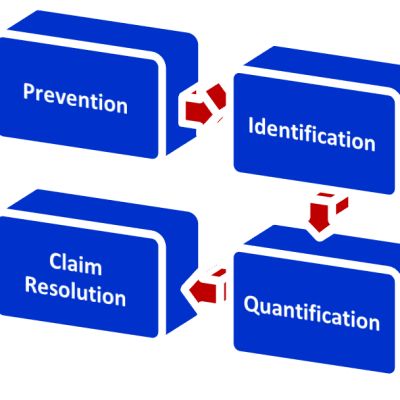
Execution of construction projects in a complex environment requires a Planning and executing a major project is an increasingly complex process that can be thrown off-course by a variety of factors such as SCQT, VUCA environment, partnerships and disputes. Add in the complexities of the collaborative process among project team, players and the result is a greater incidence of potential costly delays, disruptions and disputes.

Claim process essentially involves three basic elements – Entitlement, Notice and Methodology. Each step is significant and indispensable for the success of the claims. In today’s construction climate, resolution of claims requires leadership, analytical skills, know-how of latest software aids in project planning and technical expertise. It also hinges on having a well-conceived strategy for claims and schedule analysis.
At SECURE LEGAL, we provide Techno-Legal services throughout the project life cycle and during dispute resolution process.
• Upstream contract management activities such as facilitating formation of contract, interpretation of tender, framing replies to queries/ clarifications, tender stage correspondences with bidders ensuing a firm and binding contract.
• Developing inter parties agreements such as Term Sheets, MoU, JVs, Consortium, LOI, Inter-se agreements,
• Preparing a comprehensive contract management plan outlining the contract management process, project critical path, rights & obligations, deliverables, risks & their classification, key performance indicators and milestones, etc.
• Notices in compliance with notification and reporting requirements.
• Correspondences on contractual issues such as progress rates, variations, exceptional events, delays, Insurance, Changes in Law, price adjustments, other unforeseen situation & circumstances.
• Examination of claims, independently examine strengths and weaknesses (item-wise) of such claims / variations. Provide unbiased fact based opinion(s) whether these claims/ variations are tenable vis-à-vis a technical, financial and / or contractual standpoint or not.
• Develop strategy for mitigation of such claims.
• Perusal of project documentation and hold meetings with project personnel at Sites and offices for appreciation of facts and collection of data pertaining to notices and claims.
• Perusing progress reports, project programmes, highlighting critical contractual issues.
• Monitoring critical path, causal effect of delays thereof, entitlement of EOT during execution
• Developing time extension correspondences, contract amendments, change / variation orders, change of name / substitution of contractor, etc.
• Review baseline schedule and update on periodic basis
• Identifying opportunities to raise claims and developing such claims

Methodology

The Critical Path
The critical path is dynamic. It can fluctuate throughout a project’s life cycle, which will be reflected in the contemporaneous schedule updates. The critical path can aid in determining: –


Scheduling Analysis Methodologies – Various Types
The choice of method of delay analysis to be deployed should be determined by careful reading the contract, understanding causal effect relationship, nature and complexity of the Project, value of dispute, nature, extent and quality of documentation and practical considerations w.r.t. time window and capability of forum where the claims are being assessed.
Contemporaneous analysis is widely accepted, well proven and gives better results than the “Rather wait and see approach” or “retrospective analysis”. From the above kinds, the Impacted As-Planned and Time Impact Analysis or Window Analysis are methods recommended and practiced by SECURE LEGAL for delay analysis for the construction ecosystem.
Impacted As-Planned
A delay to progress of any activity on the critical path will, without acceleration or re-sequencing, causes the overall project duration to be extended, and is therefore referred to as a “critical delay.” On the other hand, delay to an activity which is not on the critical path will not cause delay to the overall completion date of the project, because non-critical activities have float.

Time-Impact Analysis or Windows Analysis
The time impact analysis involves inserting delay events sub-networks into logic linked baseline programme and recalculation of this updated programme using CPM programming software to determine the forecasted dates of completion prospectively.




SECURE LEGAL offers claims and schedule analysis and provide expert testimony services using good practices and phased approach.